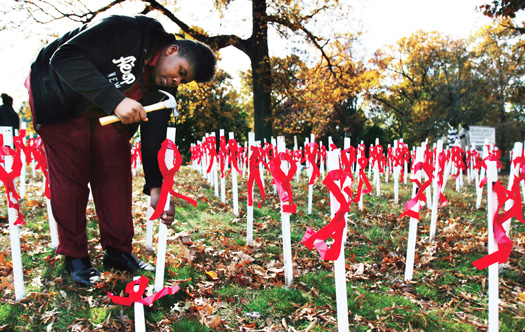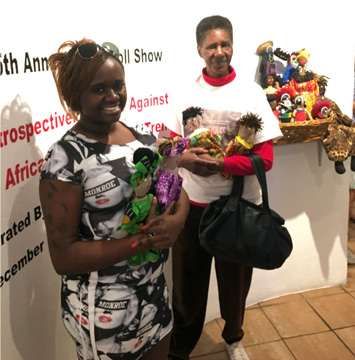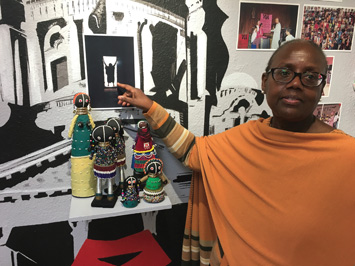By Charlene Muhammad CHARLENEM

In 30 years of the HIV/AIDS pandemic, Blacks now bear the brunt of the epidemic, which has killed nearly 300,000 Blacks in the United States, according to the Centers for Disease Control and Prevention.
After millions of dollars in funding, national awareness, prevention, and treatment campaigns, why is AIDS still killing Black folk? What is at the root of Black America’s unchecked and alarming death and infection rates?
Some attribute the problem to a lack of funding for AIDS education. Some said it is because the government is pushing drugs for treatment and prevention, and others said the problem is behavior.
According to the CDC, an estimated 270,726 Blacks with AIDS have died since the epidemic began, including an estimated 6,540 in 2012. Of the more than 1.2 million people in the United States living with HIV, Blacks accounted for an estimated 44 percent of new infections in 2010, though just 12 percent of America’s population. Blacks also accounted for 41 percent of people living with HIV in 2011, the CDC indicated.

Young, Black men bear the brunt of the disease among gay, bisexual, and other men who have sex with men. In 2010, young, Black males aged 13-24 comprised the greatest number of new HIV infections (4,800).
They were 45 percent of new infections among Black men having sex with men and 55 percent of new HIV infections among young men having sex with men overall.
Blacks were the second highest number of infections among older males (10,600), compared to Whites (11,200).
Black women saw a 21 percent decrease in infections between 2008 and 2010, but they are still far more infected than other women, according to the CDC. The rate of new HIV infections among Black women in 2010 was 20 times that of White women and nearly five times that of Hispanic women.
“Every year, they say it’s an epidemic among young, Black men. … It was an epidemic then among young, Black men … they say this crap about the new face of AIDS. No. It’s the old, neglected epidemic, but it ain’t new,” said Cleo Manago, a Washington, D.C.-based behavioral health expert and founder of the AmASSI (African, American Advocacy, Support Services and Survival Institute).
Pimping AIDS?
“Context is everything, and it is important to remember, Blacks have been operating inside the structure of White supremacy, and their methodologies are ineffective” said Mr. Manago.
“When these reports come out, that the Black HIV problem is off the chain, that same report came out in the 90s. It came out in the early 2000s. We’re now in 2016. The same report, and everybody keeps chewing on their Popeye’s chicken and going on about their business,” Mr. Manago said.
“The statistics for Black folks and HIV/AIDS has not improved in 30 years. It’s getting worse, but to say it’s getting worse visualizes the fact that it’s never been good. It’s always been bad,” Mr. Manago said.

Essentially what has been funded has not really worked, he told The Final Call. Over the last 30 years, reports and analysis released consistently narrated that young, Black men and women are highly and disproportionately impacted, but the push of repetitive data and claims of a crisis have never been accompanied or prefaced by any report that there has ever been a reduction, Mr. Manago argued.
“It’s always been high, because the Black community has never, ever been properly addressed when it comes to this issue. … There is no expectation for there to be any improvement in terms of reducing the epidemic, so now a crisis is being pimped,” Mr. Manago charged.
AIDS is still killing Black folks due to a lack of competency and cohesion among Black advocates, and people’s exploitation and lack of accountability for that, he said.
High infections, low funding
With infection rates as high as the CDC reports, why are Black HIV/AIDS organizations at the bottom of the list when it comes to direct funding as well as resources filtered through state agencies, activists asked?
Some surmised that is because they speak out against the disparities in funding.
The CDC does not breakdown funding into education, prevention, or treatment categories, according to Kathleen LaPorte of the CDC’s National Center for HIV/AIDS, Viral Hepatitis, STD, and TB Prevention Office of Planning and Policy Coordination.
Rather, it focuses with partners on new approaches including testing, linkage and retention to care and viral suppression, assertively rolling out PrEP (comprehensive pre-exposure prophylaxis, offered as one-pill-a-day to prevent HIV infection), and providing funding to most-affected populations–especially gay/bisexual men of color and transgender individuals.
Currently, the CDC receives approximately $788 million to support HIV prevention in the United States, according to Ms. LaPorte.
In Houston, Texas’ Harris County, Blacks account for 54 percent of the more than 27,650 individuals with HIV/AIDS, the AIDS Foundation Houston indicated.
According to the CDC, for the fiscal year 2011, Change Happens!, a non-profit outpatient alcohol and drug and HIV prevention organization based in the predominantly Black Third Ward neighborhood, received $335,748 in CDC funds as part of a total of $12.3 million in funding.
In Los Angeles, two Black founded organizations received money directly from the CDC’s $25.1 million allocation. They were the Black AIDS Institute, $406,125, and I Choose Life Health and Wellness Center, $120,000, through the Act Against AIDS Leadership Initiative.
The county itself provided funds to more than 70 organizations to provide HIV-related services, among them culturally competent organizations that serve Blacks such as Watts Healthcare, a full service health center; the Oasis Clinic at Martin Luther King, Jr. Hospital; and T.H.E. (To Help Everyone) Clinic and Hubert Humphrey–all located in South Los Angeles and populated mostly by Blacks and Latinos, according to Mario Perez, director of the Los Angeles County Division of HIV and STD Programs.
In Atlanta, where 68 percent of the nearly 27,000 people living with HIV or AIDS were Black, BMX-National, Inc. or Black Men’s Xchange, which serves same gender loving Black men; 100 Black Men of America, Inc. and the Southern Christian Leadership each received $120,000.
AID Atlanta, Inc., established in response to the devastating impact that HIV/AIDS was having on gay men in Atlanta, received $895,642, in part to work on prevention projects for young men of color who have sex with men and transgender persons of color.
The San Francisco AIDS Foundation reported Blacks represented 11 percent of new diagnoses in 2014, but were just six percent of the population. Aside from the bulk of $16.8 million given to universities and state agencies: STOP AIDS Project, Inc., which services gay and bisexual men of diverse ages, ethnicities and religions, received $254,800. The Asian and Pacific Islander American Health Forum received $830,074. The Asian and Pacific Islander Wellness Center received $794,205. Larkin Street Youth Services, which helps youth between 12-24 from diverse racially, ethnically, and socioeconomic backgrounds to rebuild their lives, received $335,748.
No agencies, such as the Rafiki Coalition for Health and Wellness in San Francisco, founded by Blacks to specifically address the problems of HIV/AIDS in the community, received any direct funding in San Francisco.
Perry Lang, executive director of the Rafiki Coalition, said funding Black HIV/AIDS organizations is a multi-pronged problem. The first thing that must be addressed is capacity, he said.
Many Black organizations are small, underfunded, and lack the capacity to manage some of the grants that come through. The indirect grants small organizations may get from the city and county are much lower than they would get from the federal government, he explained.
These grants are essential, because they handle accounting, human resources, communications and technical areas. Without them, it is hard to compete for larger dollars, he said.
“The second piece of this is, it seems as though the larger institutions are getting the dollars, despite the fact that they are not in touch with the population that is most impacted. I do think that needs to be changed,” Mr. Lang told The Final Call.
He recommended that federal or local governments help smaller operations with capacity grants and larger AIDS institutions subcontract with smaller ones for on-the-ground work where the epidemic is.
“Often times, they want our people to do outreach, but not necessarily conduct the services. And outreach is one thing, but if you’re not culturally competent to address the needs of the target population, you won’t retain them, and they won’t get the information they need,” Mr. Lang said.
The Rafiki Coalition does not receive any funding from larger organizations, though it has been asked to conduct outreach in the past. It raises money to keep the doors open through social entrepreneurism and addressing HIV/AIDS as well as other health problems disproportionately affecting Blacks, such as diabetes, and heart disease.
HIV facts and myths
Blacks, and people in general, are still suffering with HIV/AIDS because they are operating off of the wrong facts, stated Dr. Abdul Alim Muhammad of the Abundant Life Clinic, based in Maryland.
Initial reports in 1982 that HIV started first among gay, White men is an urban myth, he said.
“It was never true. The reason that we know that it is a false story is because, if you actually do the math that has to do with the transmission of HIV and AIDS, you can never account for the total number of people if you start with those few first cases. … You cannot actually mathematically show that you could end up with the total number of infections that you have today based on that starting point, because its mathematically impossible.”
Gay men were recruited into an experimental study regarding the Hepatitis B vaccine, which jump started the infection of gay men, Dr. Muhammad said.
Once AIDS was artificially transmitted into a certain population, other modes of transmission began to take over, he said.
From start to finish, he said, referencing an article in the May 11, 1987 edition of the London Times (“Smallpox vaccine ‘triggered’ Aids virus”), the true history of HIV is that it was a biological weapon delivered via hypodermic syringes under the cover of vaccinations.
“So you say where did all of these Black people get HIV? They were given it by vaccinations. They are still doing that,” Dr. Muhammad charged.
According to Dr. Muhammad, HIV is not a sexually transmitted disease. “There’s a lot of mythology, and that is why the epidemic is still out of control, because the truth about it is not being told … It’s teaching the public, and it’s teaching professionals things that are not true. So then when they apply what they think that they know, it doesn’t work,” Dr. Muhammad said.
“Of course, the government who is responsible for the epidemic would never knowingly fund anything that would positively affect the epidemic, because the epidemic is doing exactly what it was designed to do. It’s killing people,” he added.
Drug pushing?
According to the CDC, numerous studies have shown people who take PrEP daily can reduce their risk of contracting HIV by more than 90 percent. However, while the drug has the potential to dramatically alter the course of the HIV epidemic, it is not the only solution, a CDC spokesperson told The Final Call.
Still, the drug can help with a longer, healthier life, according to Phil Wilson, founder of the Black AIDS Institute. He feels America is in the best and worst of times with HIV, and advocates testing and treatment. There have been tremendous advances in HIV testing since 2013, he said.
“Today you can get HIV tests and you don’t have to draw blood. You can get the results back in a minute. You can take an HIV test in the privacy of your home,” he stated.
Before, it took six to eight weeks to develop antibodies, but now with acute HIV testing, if a person is exposed today, they can find out if they are positive next week, Mr. Wilson explained.
He also cited advances in tracking the epidemic right down to hot spots by zip codes, and treatment advances that are simpler, more effective, and less toxic.
“Today, if a 20-year-old person tests HIV positive, they go on treatment right away, they can live a normal life expectancy to 70- or 80-years-old,” Mr. Wilson said.
“We now know that the virus begins to do damage at the point it enters your body. Before people used to say you should wait to go on treatment. Now we know you should go on treatment right away, and it makes sense,” Mr. Wilson reflected.
“Can you imagine going to the doctor and the doctor saying you have cancer, and well, we’re not going to treat you today. We’re going to wait until it gets really, really bad. That never really made sense,” he said.
One problem is Blacks don’t know there are various tools to help curb HIV/AIDS, Mr. Wilson said. “They still think it’s the AIDS epidemic of the 1980s or 1990s or the 2000s, and it’s not. It’s a different epidemic,” he said.
He recommends addressing the lack of treatment in Black communities and awareness of raising HIV science and literacy.
“We need to fight the denial. We need to get folks to kind of get over some of their old ideas, and we need to address the stigma. We’re talking about a medical condition. We’re talking about a virus that infects people, makes people sick, kills people, and we need to look at it that way,” Mr. Wilson said.
“We need to abandon all of the moral judgment and all these other things that interrupt the work that we have to do to save our people,” he continued.
For Tony Wafford, founder of the L.A.-based I Choose Life campaign, the problem of limited funding to Black HIV/AIDS organizations amounts to pushing drug treatment as prevention, instead of education outreach.
“It’s like a concession–everybody’s going to get it. Let’s just make sure they can get some medicine for it,” he said.
“One year they gave a contract for right at $100,000. Well, what am I going to do with $100,000 a year to do education and prevention? What are you really going to do? They just throw something at you to keep you quiet, but they wouldn’t even dream of giving gay, White agencies $100,000,” Mr. Wafford told The Final Call. The amount of money is actually very small, he said.
He acknowledged President Barack Obama’s National HIV Strategy, but a strategy without funding is just a great idea, Mr. Wafford said.
The strategy aims to reduce new HIV infections, increase access to care, reduce HIV-related disparities and health inequities and achieve a more coordinated response to the epidemic.
“Certainly one could be honest and say that a lot of it was because Congress would try to block everything that he may try to do, and certainly around HIV and Black people,” Mr. Wafford said. But he feels President Obama’s administration could have gotten more creative in redirecting money that was already allotted, moving money around, and just getting on the phone and talking to pharmaceutical companies.
Mr. Wafford’s argument over the treatment PrEP: Why should people spend $1,400 a year to buy a pill they do not need to treat something they do not have versus $15 for a 26 pack of condoms?
“You cannot and you will not get away from personal responsibility, and that’s what we seem to do. That’s like the American way,” he said.












